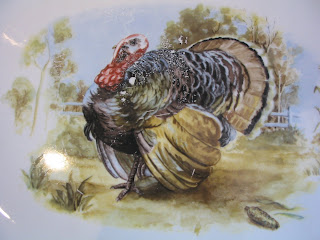Giving Thanks to Sarah
Today as you sit down to enjoy your turkey dinner, give thanks to Sarah. Sarah Josepha Hale. She's the one who is largely responsible for Thanksgiving as you know it. (I'm showing my geek side here, but Thanksgiving has a kind of interesting history, so bear with me. Or come back to the blog next week when I'll surely have more cute things to say about your favorite twins.)
Like many traditions Thanksgiving has changed over time, but it began with the persistent efforts of a nineteenth-century magazine editor. Well, actually, it began as an occasional harvest festival. Long before the Mayflower set sail, harvest celebrations were commonplace, though not necessarily codified and annual, in England and among many Native American groups. In the New World during the late eighteenth and early nineteenth centuries, Thanksgiving was primarily a regional New England holiday celebrating family and community; it was largely unknown in the South. I'm sure the people in Colorado at that time weren't celebrating it either.
 In the early nineteenth century when America was a generation past the revolution, struggling to establish a national identity, and tensions between the North and South were mounting, the only national holidays were Washington's Birthday and Independence Day. Sarah Josepha Hale, editor of a women's magazine called Godey's Ladies Book and Magazine, thought her country needed a holiday centered on the family, a holiday women could enjoy, a holiday that wasn't all about men, guns, and war. Hale envisioned a day when far-flung relatives traveled home to be together, and wanted all the states and territories to celebrate this holiday on the same day to unite the nation.
In the early nineteenth century when America was a generation past the revolution, struggling to establish a national identity, and tensions between the North and South were mounting, the only national holidays were Washington's Birthday and Independence Day. Sarah Josepha Hale, editor of a women's magazine called Godey's Ladies Book and Magazine, thought her country needed a holiday centered on the family, a holiday women could enjoy, a holiday that wasn't all about men, guns, and war. Hale envisioned a day when far-flung relatives traveled home to be together, and wanted all the states and territories to celebrate this holiday on the same day to unite the nation.
Fortunately, Sarah had a forum: as editor of Godey's Ladies Book and Magazine she used the pages of her publication to lobby for a national day of thanksgiving. Hale published articles touting how nice it would be to have a family holiday, she published fiction stories featuring families reuniting for Thanksgiving bringing joy to all, and she even prescribed the menu with recipes in her magazine: turkey, oyster soup, vegetables in cream sauce, and pumpkin pie. Hale was practical in her approach: she suggested the holiday fall on a Thursday so women could prepare a Thanksgiving Feast without disrupting their responsibility to provide a Sunday dinner for the family. She wrote to senators, secretaries of state, and presidents to make her case. Other magazines picked up on her efforts and began including their own propaganda for a national Thanksgiving.
Ms. Hale was one tenacious lady. She joined Godey's Lady Book in 1827, and began her efforts around 1846. She kept it up until (finally) President Lincoln declared the first national Thanksgiving in 1863. She edited the magazine until 1877, and even after her victory in 1863 she continued to promote her Thanksgiving agenda.
For decades after Lincoln declared the first Thanksgiving, Presidents announced the holiday each year, always on the last Thursday of November; the holiday wasn't automatic, it had to be re-declared each year. 1939 was a month with five Thursdays, meaning the last Thursday fell late on the calendar. Fred Lazarus, who would eventually own Federated Department stores (which today owns Macy's and Bloomingdale's), realized that this would affect his Christmas revenue. So, Mr. Lazarus appealed to his friend President Roosevelt and convinced the President to declare Thanksgiving a week early. In 1941 Congress permanently set the official day of the legal holiday as the fourth Thursday in November, which is, of course, when we celebrate it today.
By the way, there was a first Thanksgiving in Plymouth, Massachusetts in October 1621. The pilgrims wanted to offer thanks because their successful harvest would mean the settlers could survive the coming winter (the previous winter had been a bit of a disaster). They invited the Wampanoag leader to join their celebration, and he in turn brought 90 Native Americans (and five deer) to the feast. The event lasted three days, and there were foot races and shooting games in addition to feasting. Revelers dined on a meal of venison, fowl, corn, cod, pumpkin, squash, lobster, mussels, and grapes. The only surviving written account of the event does not mention turkey; historians believe that the fowl was most likely geese or duck.
Here in Boulder we're sticking to tradition, not just with turkey, but with a couple of Juniper's father's recipes. I hope as you read this you're with close friends and family and are enjoying the day together. Just the way Sarah wanted it.
Like many traditions Thanksgiving has changed over time, but it began with the persistent efforts of a nineteenth-century magazine editor. Well, actually, it began as an occasional harvest festival. Long before the Mayflower set sail, harvest celebrations were commonplace, though not necessarily codified and annual, in England and among many Native American groups. In the New World during the late eighteenth and early nineteenth centuries, Thanksgiving was primarily a regional New England holiday celebrating family and community; it was largely unknown in the South. I'm sure the people in Colorado at that time weren't celebrating it either.
 In the early nineteenth century when America was a generation past the revolution, struggling to establish a national identity, and tensions between the North and South were mounting, the only national holidays were Washington's Birthday and Independence Day. Sarah Josepha Hale, editor of a women's magazine called Godey's Ladies Book and Magazine, thought her country needed a holiday centered on the family, a holiday women could enjoy, a holiday that wasn't all about men, guns, and war. Hale envisioned a day when far-flung relatives traveled home to be together, and wanted all the states and territories to celebrate this holiday on the same day to unite the nation.
In the early nineteenth century when America was a generation past the revolution, struggling to establish a national identity, and tensions between the North and South were mounting, the only national holidays were Washington's Birthday and Independence Day. Sarah Josepha Hale, editor of a women's magazine called Godey's Ladies Book and Magazine, thought her country needed a holiday centered on the family, a holiday women could enjoy, a holiday that wasn't all about men, guns, and war. Hale envisioned a day when far-flung relatives traveled home to be together, and wanted all the states and territories to celebrate this holiday on the same day to unite the nation.Fortunately, Sarah had a forum: as editor of Godey's Ladies Book and Magazine she used the pages of her publication to lobby for a national day of thanksgiving. Hale published articles touting how nice it would be to have a family holiday, she published fiction stories featuring families reuniting for Thanksgiving bringing joy to all, and she even prescribed the menu with recipes in her magazine: turkey, oyster soup, vegetables in cream sauce, and pumpkin pie. Hale was practical in her approach: she suggested the holiday fall on a Thursday so women could prepare a Thanksgiving Feast without disrupting their responsibility to provide a Sunday dinner for the family. She wrote to senators, secretaries of state, and presidents to make her case. Other magazines picked up on her efforts and began including their own propaganda for a national Thanksgiving.
Ms. Hale was one tenacious lady. She joined Godey's Lady Book in 1827, and began her efforts around 1846. She kept it up until (finally) President Lincoln declared the first national Thanksgiving in 1863. She edited the magazine until 1877, and even after her victory in 1863 she continued to promote her Thanksgiving agenda.
For decades after Lincoln declared the first Thanksgiving, Presidents announced the holiday each year, always on the last Thursday of November; the holiday wasn't automatic, it had to be re-declared each year. 1939 was a month with five Thursdays, meaning the last Thursday fell late on the calendar. Fred Lazarus, who would eventually own Federated Department stores (which today owns Macy's and Bloomingdale's), realized that this would affect his Christmas revenue. So, Mr. Lazarus appealed to his friend President Roosevelt and convinced the President to declare Thanksgiving a week early. In 1941 Congress permanently set the official day of the legal holiday as the fourth Thursday in November, which is, of course, when we celebrate it today.
By the way, there was a first Thanksgiving in Plymouth, Massachusetts in October 1621. The pilgrims wanted to offer thanks because their successful harvest would mean the settlers could survive the coming winter (the previous winter had been a bit of a disaster). They invited the Wampanoag leader to join their celebration, and he in turn brought 90 Native Americans (and five deer) to the feast. The event lasted three days, and there were foot races and shooting games in addition to feasting. Revelers dined on a meal of venison, fowl, corn, cod, pumpkin, squash, lobster, mussels, and grapes. The only surviving written account of the event does not mention turkey; historians believe that the fowl was most likely geese or duck.
Here in Boulder we're sticking to tradition, not just with turkey, but with a couple of Juniper's father's recipes. I hope as you read this you're with close friends and family and are enjoying the day together. Just the way Sarah wanted it.


Comments
we had a huge and exhausting feast, and i'm headachy and weary today. but i'll do it all again next year, hopefully in our real dining room, family style instead of buffet like we had to do this year (more people than dining-room-table seats). glad you had a good family feast, too. love, me.